
Dawn song; Cuba. © Andy Mitchell
Dawn song; Bahamas. © Jesse Fagan
Call; Bahamas. © Jim Holmes
Dawn song; Jamaica. © Richard C. Hoyer
Birdfinding.info ⇒ Common throughout its range. Tends to occupy more heavily wooded terrain than the other kingbirds that occur in its range. Can be found at all the wooded sites frequented by birdwatchers on Grand Bahama, Abaco, Andros, Cuba (including adjacent islands such as Cayo Coco), Grand Cayman, and Jamaica.
Loggerhead Kingbird
Tyrannus caudifasciatus
Family: Tyrannidae
Endemic to the western Caribbean: the Bahamas, Cuba and its satellites, the Cayman Islands, and Jamaica. In the Bahamas, occurs on Grand Bahama, Abaco, Andros, New Providence, and some adjacent cays.
Occurs in open woodlands at all elevations, from coastal scrub and mangroves to montane forests.
Identification
Roughly intermediate in appearance between two more widespread species that occur throughout its range, with plumage similar to Eastern Kingbird but the more robust structure of Gray Kingbird.
Like Eastern, Loggerhead has white underparts, gray upperparts, a blackish cap, and a pale-tipped tail. The most striking difference is Loggerhead’s much longer bill. Loggerhead’s upperparts average paler than Eastern’s, and it typically shows a peaked crown.
In some plumages it has a yellow wash on the vent, which sometimes extends to the belly. This occurs to a lesser degree in the Jamaican subspecies.
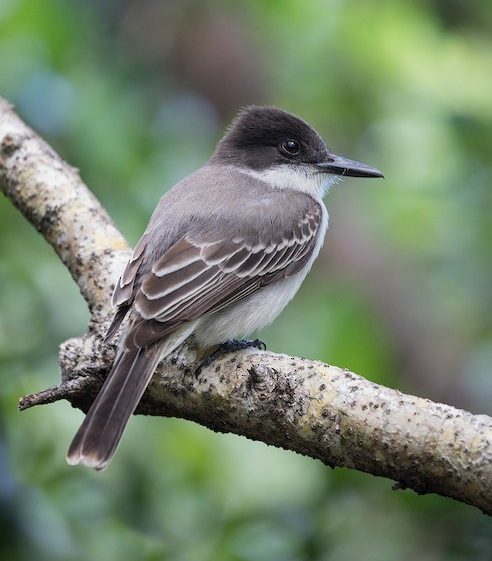
Loggerhead Kingbird, T. c. caudifasciatus. (Playa Pesquero, Holguín, Cuba; February 23, 2018.) © Suzanne Labbé
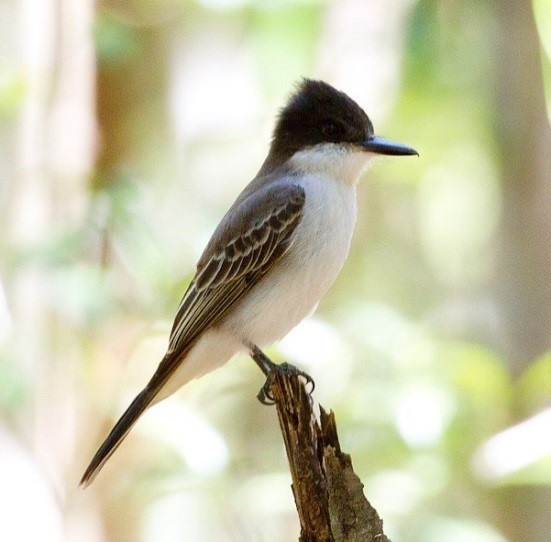
Loggerhead Kingbird, T. c. caudifasciatus. (Zapata, Cuba; March 2013.) © Ian Merrill

Loggerhead Kingbird, T. c. caudifasciatus, carrying a dead anole. (Cayo Coco, Cuba; May 3, 2013.) © William Price
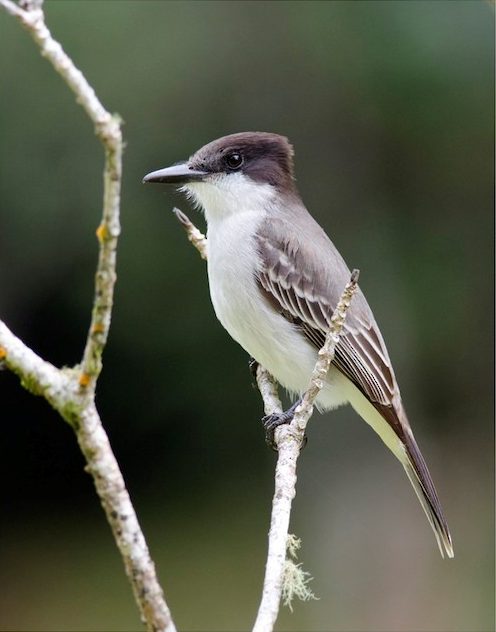
Loggerhead Kingbird, T. c. caudifasciatus, showing a slight lemon-yellow wash on the vent. (Topes de Collantes National Park, Cuba; February 18, 2015.) © Joshua D. Vandermeulen

Loggerhead Kingbird, T. c. caudifasciatus, showing entirely white underparts. (Playa Pesquero, Holguín, Cuba; February 16, 2018.) © Suzanne Labbé
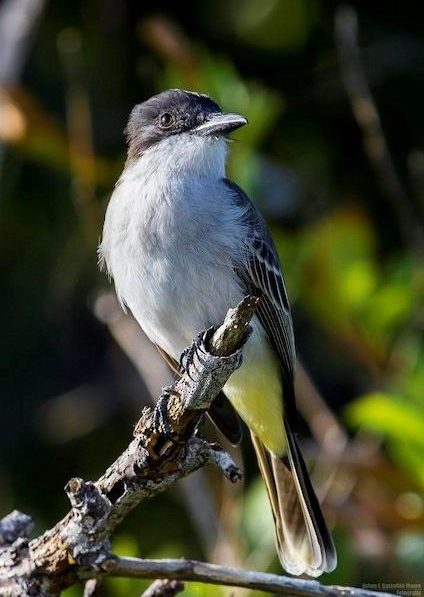
Loggerhead Kingbird, T. c. caudifasciatus, showing a bright lemon-yellow wash on the vent. (Cabo San Antonio, Pinar del Río, Cuba; October 29, 2017.) © Aslam Ibrahim Castellón Maure

Loggerhead Kingbird, T. c. caymanensis, typical plumage. (Pedro Castle, Bodden Town, Grand Cayman; March 22, 2017.) © Charmaine Anderson

Loggerhead Kingbird, T. c. caymanensis, showing a yellowish wash on the vent. (Queen Elizabeth II Botanic Park, Grand Cayman; July 22, 2018.) © Graham Gerdeman
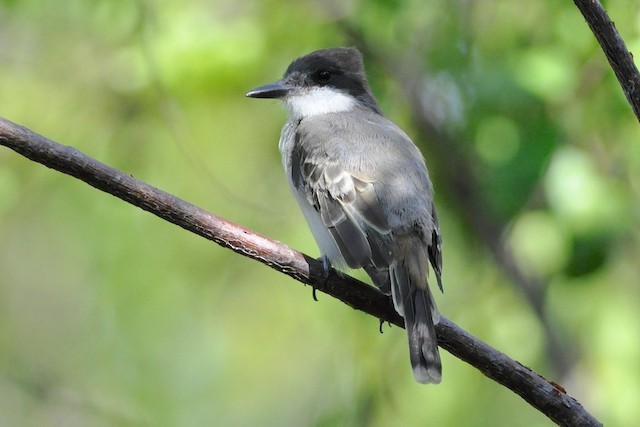
Loggerhead Kingbird, T. c. caymanensis, showing unusually pale gray upperparts. (Brac Parrot Reserve, Cayman Brac; December 26, 2014.) © Christine Kozlosky
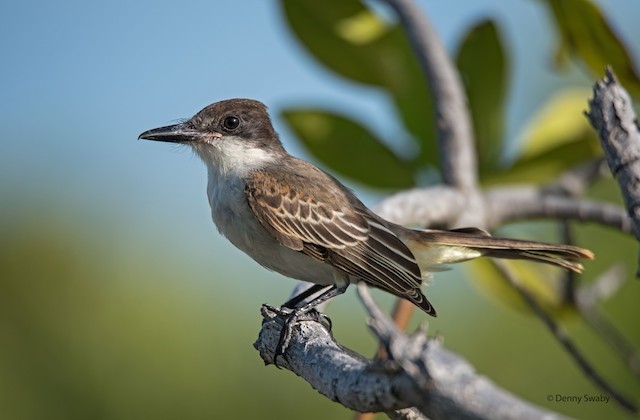
Loggerhead Kingbird, T. c. caymanensis, likely immature with muted blackish crown, brownish wings and tail, and yellowish wash on the vent. (Barkers National Park, Grand Cayman; June 25, 2016.) © Denny Swaby
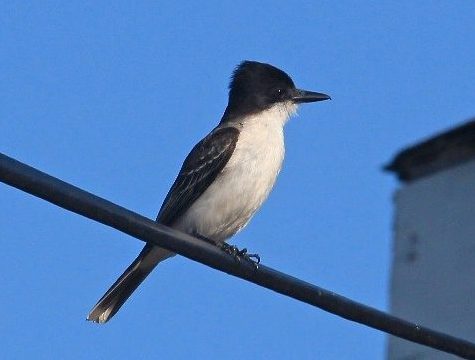
Loggerhead Kingbird, T. c. jamaicensis. (Montego Bay, Jamaica; February 20, 2014.) © Eric W. Greisen

Loggerhead Kingbird, T. c. jamaicensis, showing faint yellowish wash on vent and rusty tinge on rump. (Jamaica; November 2015.) © Greg Roberts
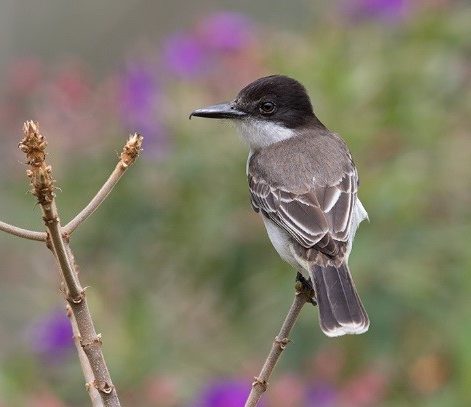
Loggerhead Kingbird, T. c. jamaicensis. (Silver Hill Gap, Jamaica; March 22, 2015.) © Sam Woods
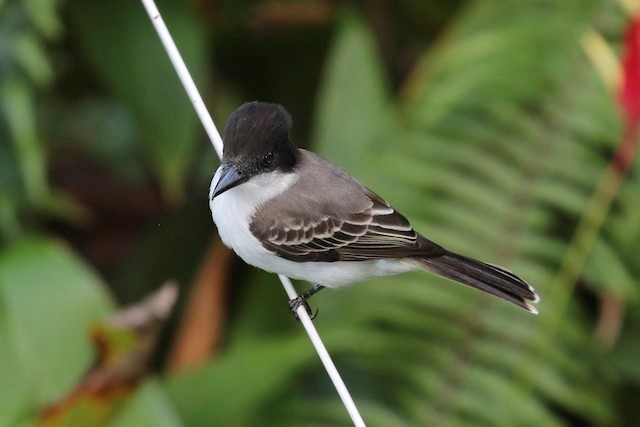
Loggerhead Kingbird, T. c. jamaicensis—note triangular shape of bill in top view. (Forres Park Nature Retreat, Jamaica; February 11, 2015.) © Knut Hansen
The Bahama subspecies differs visibly from the others in being, on average, less crisply black-and-white, more “washed out” overall than the others. Its upperparts range from pale gray to brownish or olive, with a rusty tinge on the rump. Its crown is typically paler and more rounded than on the other subspecies. The tip of its tail is buffy where the others are white or whitish-gray.

Loggerhead Kingbird, T. c. bahamensis. (Blue Hole, Abaco, Bahamas; December 13, 2018.) © Kent Forward
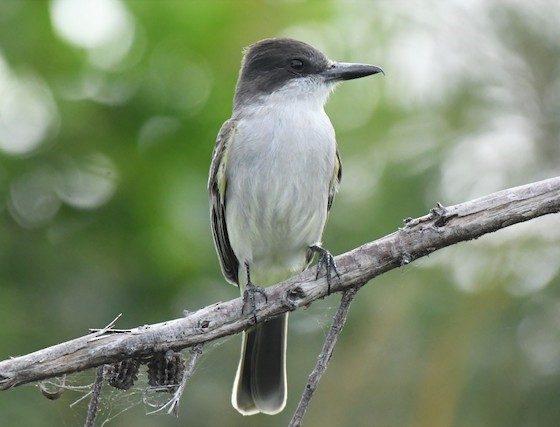
Loggerhead Kingbird, T. c. bahamensis, showing a slight yellowish wash on the belly. (Reef Golf Course, Freeport, Grand Bahama; March 5, 2018.) © Christopher Johnson
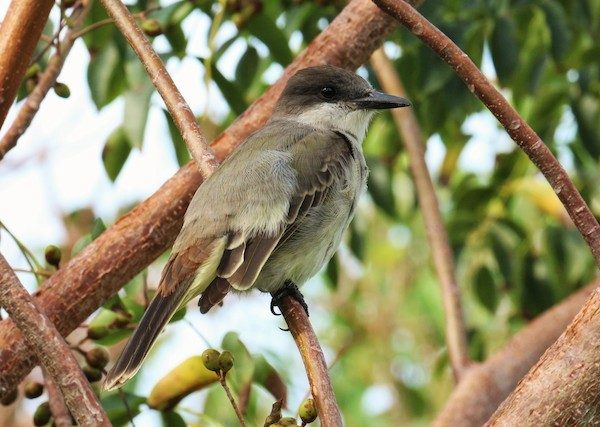
Loggerhead Kingbird, T. c. bahamensis, showing olive back, yellowish vent, and rusty-tinged rump. (Casaurina Point, Abaco, Bahamas; December 10, 2015.) © Jason Estep
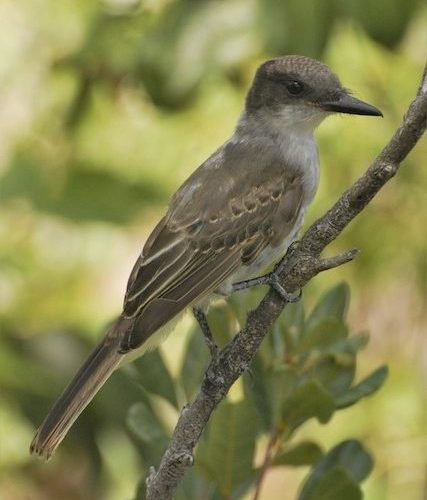
Loggerhead Kingbird, T. c. bahamensis, juvenile still entering first plumage. (Churches Blue Hole, Andros, Bahamas; August 16, 2013.) © David Hollie
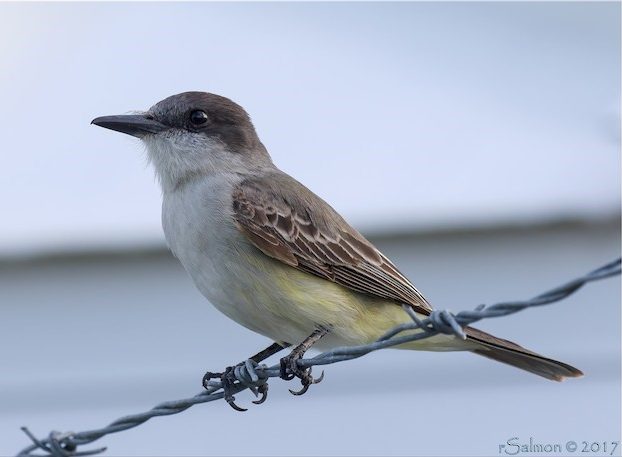
Loggerhead Kingbird, T. c. bahamensis. (Marsh Harbour, Abaco, Bahamas; March 24, 2017.) © Frank Salmon

Loggerhead Kingbird, T. c. bahamensis, with extensive yellow wash on vent and belly. (March Harbour, Abaco, Bahamas; April 8, 2017.) © Greg Stuart
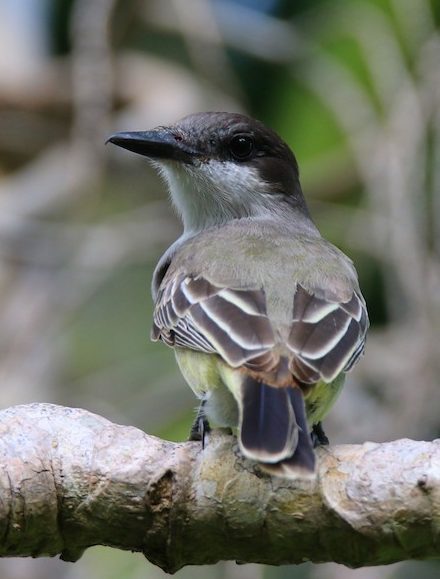
Loggerhead Kingbird, T. c. bahamensis, showing olive back, yellowish vent, and rusty-tinged rump. (Garden of the Groves, Grand Bahama; January 11, 2018.) © Karmela Moneta
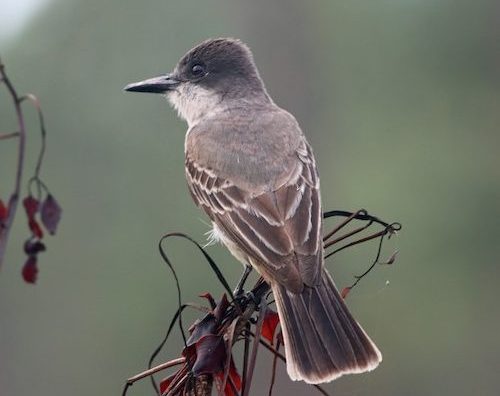
Loggerhead Kingbird, T. c. bahamensis, showing brownish back and pale edges and tips on the tail. (Blue Hole, Abaco, Bahamas; May 25, 2017.) © Brendan Fogarty
Voice. Loggerhead Kingbirds have various vocalizations, some soft and some harsh, with wide variation among the subspecies. This variability is wide enough to suggest possible future subdivision into multiple species.
The nominate subspecies (of Cuba and its satellites) has a distinctive song, a chuckling trill, then a loud cackle that subsides into a brief high-pitched trill: One of its other calls is a descending trill:
The song of bahamensis is similar to the Cuban’s in phrasing but mellower, more liquid in tone: Other calls of bahamensis include brief, single-tone trills:
The song of jamaicensis is very different from the others: a cackle that resembles the phrasing of a Great Kiskadee:
As an indication of the breadth of vocal variability among subspecies, Garrido et al. (2009) present the following comparison of sonograms representing samples of dawn songs from each subspecies, as well as Hispaniolan and Puerto Rican Kingbirds:
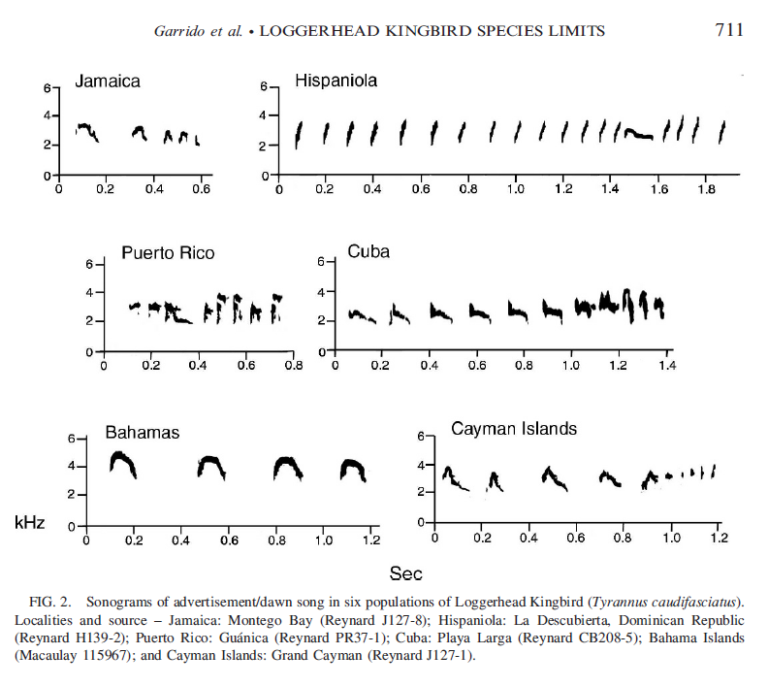
Cf. Giant Kingbird. On Cuba, the localized endemic Giant Kingbird is very similar to Loggerhead, but has a much larger bill and an all-dark, notched tail.
Cf. Gray Kingbird. Confusion with Gray is possible under some circumstances. Loggerhead has an entirely blackish cap and dark gray upperparts, whereas Gray has a blackish mask and pale gray crown and back. Some Loggerheads are paler than average and may resemble Grays, although most birds show the head pattern typical of one species or the other. In close cases, the best diagnostic feature is the tail: square and white-tipped in Loggerhead versus notched and all-dark in Gray. Bill shape also differs, as Loggerhead’s usually appears much thinner and less graduated than Gray’s.
The plumage of bahamensis is generally more washed-out than that of other subspecies and thus more similar to Gray’s. (For photo comparisons of bahamensis with Gray Kingbird, see Rolling Harbour Blog, Tyrants of Abaco: Flycatcher ID (I) – Loggerhead vs. Gray Kingbird, https://rollingharbour.com/2015/04/13/tyrants-of-abaco-flycatcher-id-1-loggerhead-vs-gray-kingbird/.)
Cf. Hispaniolan and Puerto Rican Kingbirds. Loggerhead does not overlap with Hispaniolan or Puerto Rican Kingbirds. For out-of-range individuals, the key characteristic of Loggerhead is its squarish, pale-tipped tail. Both Hispaniolan and Puerto Rican have all-dark, notched tails. Hispaniolan is also much browner above, with rufous highlights, resembling certain Myiarchus flycatchers.
Notes
Polytypic species consisting of four recognized subspecies: bahamensis (northern Bahamas), caudifasciatus (Cuba and adjacent islands), caymanensis (Cayman Islands), and jamaicensis (Jamaica).
Traditionally considered conspecific with Hispaniolan and Puerto Rican Kingbirds, but Garrido et al. (2009) present persuasive evidence that the Loggerhead Kingbird complex is best regarded as multiple species based on differences in plumage and vocalizations.
The four subspecies that remain classified as Loggerhead Kingbirds differ vocally, as shown in Garrido et al.’s comparison of dawn song sonograms (see above), which could be regarded as significant enough to warrant further division. As noted above, bahamensis also differs somewhat in coloration.
References
eBird. 2019. eBird: An online database of bird distribution and abundance. Cornell Lab of Ornithology, Ithaca, N.Y. http://www.ebird.org. (Accessed February 16, 2019.)
Garrido, O.H, and A. Kirkconnell. 2000. Field Guide to the Birds of Cuba. Cornell University Press, Ithaca, N.Y.
Garrido, O.H., J.W. Wiley, and G.B. Reynard. 2009. Taxonomy of the Loggerhead Kingbird (Tyrannus caudifasciatus) Complex (Aves: Tyrannidae). Wilson Bulletin 121: 703-713.
Haynes-Sutton, A., A. Downer, R. Sutton, and Y.-J. Rey-Millet. 2009. A Photographic Guide to the Birds of Jamaica. Princeton University Press, Princeton, N.J.
Mobley, J., and E. de Juana. 2019. Loggerhead Kingbird (Tyrannus caudifasciatus). In Handbook of the Birds of the World Alive (J. del Hoyo, A. Elliott, J. Sargatal, D.A. Christie, and E. de Juana, eds.). Lynx Edicions, Barcelona. https://www.hbw.com/node/57485. (Accessed February 16, 2019.)
Raffaele, H., J. Wiley, O. Garrido, A. Keith, and J. Raffaele. 1998. A Guide to the Birds of the West Indies. Princeton University Press, Princeton, N.J.
Rolling Harbour Blog, Tyrants of Abaco: Flycatcher ID (I) – Loggerhead vs. Gray Kingbird, https://rollingharbour.com/2015/04/13/tyrants-of-abaco-flycatcher-id-1-loggerhead-vs-gray-kingbird/.